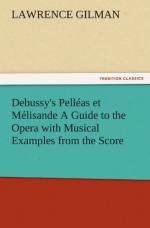It is heard again as an accompaniment to Yniold’s naive answers to Golaud’s interrogations (page 160); when he cries out that his father, in his agitation, has hurt him (page 164); and, in a particularly touching form, on page 165, measure 4, when Golaud promises that he will give him a present on the morrow if Yniold will tell him what he knows concerning Melisande and Pelleas. We hear the Pelleas theme in the strings and wood-wind (page 172, measure 7) when Yniold says that they “weep always in the dark,” and that “that makes one weep also,” and again when he tells of having seen them kiss one day—“when it rained.” Thereafter it is heard repeatedly in varying forms to the end of the scene, at times underlying a persistent triplet-figure which has the effect of an inverted pedal-point. A tumultuous and agitated crescendo passage brings the act to a portentous close.
ACT IV
A variant of the Pelleas theme, with the opening notes of the Fate motive as an under voice, begins the short prelude to the fourth act; there is a hint of the Yniold theme, and the first two notes of the Pelleas motive introduce the first scene. The interview between Melisande and her lover, in which they arrange their tryst at the fountain in the park, is treated with restraint; an expressive phrase sung by the ’cellos (page 194, measure 11) may be noted at the point where Pelleas informs Melisande that she will look in vain for his return after he has gone. The Melisande theme, in a new form, opens the moving scene between Melisande and Arkel in which he tells her of his compassionate observation of her since first she came to the castle. During his speech and her replies we hear her motive and that of Fate (page 205), the latter theme announcing the entrance of Golaud, distraught, blood-bespattered, seeking, he says, his sword. The music of the ensuing scene does not call for extended description—rather for the single comment that in it Debussy has proved once for all his power of forceful, direct, and tangible dramatic utterance: the music here, to apply to it Golaud’s phrase in the play, is compact of “blood and iron”—as well it needed to be for the accentuation of this perturbing and violent episode. The Fate motive courses ominously through its earlier portions. We hear, too, what I have called the “second” Melisande theme—that which seems to denote her naivete (see Ex. IV), and a strange variant of the first Melisande theme (page 212, measure 4). At the climax of the scene, when Golaud seizes his wife by her long hair and flings her from side to side, the music is as brutal, as “virile,” as the most exigent could reasonably demand. Later, as he hints at his purpose,—“I shall await my chance,”—the trombones, tubas, and double-basses pizzicato mutter, pp, the motive of Vengeance. The orchestral




